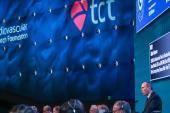SENIOR-RITA Offers Rare Insights Into Best Care for Older NSTEMI Patients
No impact was seen on mortality between the invasive and medical arms, but other endpoints may mean more to patients.

LONDON, England—An invasive strategy of coronary angiography, and revascularization if appropriate, is no better than conservative medical therapy for reducing the risk of cardiovascular mortality or nonfatal myocardial infarction in elderly patients presenting with NSTEMI, according to results from the SENIOR-RITA trial.
The trial found no significant difference in the risk of cardiovascular mortality, but there was evidence of benefit when it came to nonfatal MI and repeat revascularization, say investigators. That finding—no reduction in the risk of death—is consistent with all previous studies.
“In the context of NSTEMI, we’re not saving their lives, but we’re certainly reducing their future heart attacks and future repeat procedures,” said lead investigator Vijay Kunadian, MBBS, MD (Newcastle University, Newcastle upon Tyne, England), during a Hot Line session at the European Society of Cardiology (ESC) Congress 2024.
Simone Biscaglia, MD (Azienda Ospedaliero Universitaria di Ferrara, Italy), the discussant following Kunadian ‘s presentation, emphasized the importance of SENIOR-RITA, telling the assembled ESC audience that this unique trial took on the types of patients that usually don’t make it into randomized research.
“We are finally getting the evidence we need in such an underserved population, namely older patients with myocardial infarction,” he said. The reduction in MI and repeat revascularization is important in these older, complex patients with significant comorbidities, because “each hospitalization is associated with worsening frailty and cognitive impairment,” he said.
Speaking with TCTMD, Mirvat Alasnag, MD (King Fahd Armed Forces Hospital, Jeddah, Saudi Arabia), a member of the American College of Cardiology Interventional Cardiology Council, said older NSTEMI patients like those in SENIOR-RITA are typically treated with medical therapy given the lack of data.
The study now allows physicians to have a “level-headed conversation” and for patients to have informed consent about the risks and benefits of an invasive strategy with PCI.
“I can tell my patient that I can offer you an invasive strategy knowing that it is safe—adverse events were less than 1% in the trial—and let them know that nonfatal MIs and repeat or unscheduled revascularizations can be prevented,” she said. “There was no change in deaths in this group, but it again goes back to the conversation with our patients: maybe that isn't an endpoint for them. Maybe it isn't a goal that they want survival or longevity. Maybe they just want to prevent another MI or prevent another revascularization procedure.”
SENIOR-RITA was published simultaneously in the New England Journal of Medicine.
Older Patients Common in Practice
There have been several smaller studies comparing the invasive strategy to conservative management in elderly NSTEMI patients, including the Italian Elderly ACS Study, After Eighty, MOSCA, 80-Plus Study, and RINCAL. Only the After Eighty study showed a reduction in the risk of recurrent MI and coronary revascularization with the invasive approach, with no benefit on the risks of death. Many of these trials had limitations, said Kunadian, such as small sample sizes, no formal frailty or cognitive function assessment, or no adjudication of events.
“As our population is getting older, we’re treating more and more older patients,” said Kunadian. “We’re seeing more people coming to the cath lab with coronary artery disease and myocardial infarction, but not all older patients are the same. They’re very heterogenous, with conditions such as cognitive impairment, frailty, and multiple long-term conditions impacting their outcomes.”
SENIOR-RITA randomized 1,518 patients (mean age 82 years; 45% women) to the invasive strategy of coronary angiography followed by revascularization, if necessary, or to medical therapy with aspirin, P2Y12 receptor antagonist, statin, beta-blocker, and ACE inhibitor or ARB. Other comorbidities, such as hypertension, diabetes, and high cholesterol, were also managed based on clinical guidelines. In the invasive arm, 90.3% had angiography performed and 49.9% of these patients underwent PCI.
The patients were found in emergency departments, medical admission units, and cardiology, medical, and geriatric wards at PCI and non-PCI hospitals, said Kunadian. One out of every five patients screened were recruited, which was expected given the challenges of studying this older population. Nearly three-quarters of participants were 80 years and older, and the oldest randomized patient was 103. One-third of patients were frail, and 60% had impaired cognitive function based on the Montreal Cognitive Assessment score.
Over a median follow-up of 4.1 years, the primary endpoint—CV death or nonfatal MI assessed in a time-to-event analysis—occurred in 25.6% of patients treated invasively and 26.3% of those treated with medical therapy (HR 0.94; 95% CI 0.77-1.14). There was no difference in the risk of cardiovascular mortality (HR 1.11; 95% CI 0.86-1.44) between the two treatment strategies, but there was a 25% relative reduction in the risk of nonfatal MI (11.7% with invasive strategy vs 15.0% with medical therapy; HR 0.75; 95% CI 0.57-0.99).
The risk of subsequent coronary revascularization also was reduced with the invasive strategy (3.9% vs 13.7% with the conservative strategy; HR 0.26; 95% CI 0.17-0.39). There was no difference in the risk of stroke or bleeding between treatments.
The primary outcome findings, said Kunadian, were consistent across all subgroups, including frail and nonfrail patients as well as those with and without cognitive impairment.
Reduction in MI
Robert Byrne, MBBCh, PhD (Mater Private Network, Dublin, Ireland), one of the panelists during the Hot Line session, called SENIOR-RITA a negative trial based on the primary endpoint, noting that researchers estimated a 22% relative reduction in the primary outcome with the invasive strategy. Despite those assumptions, the negative study is largely concordant with existing data.
“We’re seeing a clear reduction in myocardial infarction, but less of a signal on mortality,” said Byrne.
Kunadian agreed with that interpretation. Earlier this year, along with lead investigator Christos Kotanidis, MD (University of Newcastle), her research group published a meta-analysis in the European Heart Journal comparing conservative versus invasive strategies for older patients with NSTEMI. Similar to SENIOR-RITA, that analysis found no difference in the risk of all-cause mortality and nonfatal MI at 1 year between the two strategies, but there was a reduction in the risk of MI.
Like others, Kunadian said that as patients get older, quality of life tends to become more important than quantity, and for that reason, freedom from events and hospitalization is important, she said.
To TCTMD, Alasnag pointed out that these results don’t apply to all elderly patients, saying the trial should be interpreted cautiously. Patients had an average GRACE score of 135, so it’s unknown how those with a higher score would fare, she said. More data on the SYNTAX score and disease complexity of randomized patients would also be welcome to better understand the trial.
“The other thing is, the study takes revascularization as a lump sum, but we’re primarily talking about PCI,” she said. “We're not talking about CABG as an option for revascularization. Only 3% of the SENIOR-RITA patients underwent CABG, so I think it is going to be important that we interpret these results for patients who require CABG differently.”
Biscaglia pointed out that the timing of revascularization also matters, noting that revascularized patients in the invasive arm underwent PCI a median 5 days after admission for NSTEMI, and this might explain the findings. Additionally, complete revascularization is important as they showed last year in the FIRE trial. Of the patients with multivessel disease in SENIOR-RITA, just 30% were treated with multivessel PCI.
“It would be interesting to understand whether a complete revascularization could [lead] to a better outcome compared with the more conservative strategy,” said Biscaglia.
Michael O’Riordan is the Managing Editor for TCTMD. He completed his undergraduate degrees at Queen’s University in Kingston, ON, and…
Read Full BioSources
Kunadian V, Mossop H, Shields C, et al. Invasive treatment strategy for older patients with myocardial infarction. N Engl J Med. 2024;Epub ahead of print.
Disclosures
- Kunadian reports no relevant conflicts of interest.






Comments